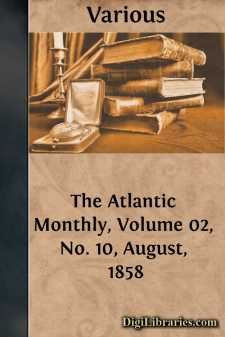Categories
- Antiques & Collectibles 13
- Architecture 36
- Art 48
- Bibles 22
- Biography & Autobiography 813
- Body, Mind & Spirit 142
- Business & Economics 28
- Children's Books 15
- Children's Fiction 12
- Computers 4
- Cooking 94
- Crafts & Hobbies 4
- Drama 346
- Education 46
- Family & Relationships 57
- Fiction 11828
- Games 19
- Gardening 17
- Health & Fitness 34
- History 1377
- House & Home 1
- Humor 147
- Juvenile Fiction 1873
- Juvenile Nonfiction 202
- Language Arts & Disciplines 88
- Law 16
- Literary Collections 686
- Literary Criticism 179
- Mathematics 13
- Medical 41
- Music 40
- Nature 179
- Non-Classifiable 1768
- Performing Arts 7
- Periodicals 1453
- Philosophy 64
- Photography 2
- Poetry 896
- Political Science 203
- Psychology 42
- Reference 154
- Religion 513
- Science 126
- Self-Help 84
- Social Science 81
- Sports & Recreation 34
- Study Aids 3
- Technology & Engineering 59
- Transportation 23
- Travel 463
- True Crime 29
The Atlantic Monthly, Volume 02, No. 10, August, 1858
by: Various
Categories:
Description:
Excerpt
DAPHNAIDES:
OR THE ENGLISH LAUREL, FROM CHAUCER TO TENNYSON.
And for their worthines full oft have bore
The crown of laurer leavés on the hede,
As ye may in your oldé bookés rede:
And how that he that was a conquerour
Had by laurer alway his most honour.
DAN CHAUCER:The Flowre and the Leaf.
It is to be lamented that antiquarian zeal is so often diverted from subjects of real to those of merely fanciful interest. The mercurial young gentlemen who addict themselves to that exciting department of letters are open to censure as being too fitful, too prone to flit, bee-like, from flower to flower, now lighting momentarily upon an indecipherable tombstone, now perching upon a rusty morion, here dipping into crumbling palimpsests, there turning up a tattered reputation from heaps of musty biography, or discovering that the brightest names have had sad blots and blemishes scoured off by the attrition of Time's ceaseless current. We can expect little from investigators so volatile and capricious; else should we expect the topic we approach in this paper to have been long ago flooded with light as of Maedler's sun, its dust dissipated, and sundry curves and angles which still baffle scrutiny and provoke curiosity exposed even to Gallio-llke wayfarers. It is, in fact, a neglected topic. Its derivatives are obscure, its facts doubtful. Questions spring from it, sucker-like, numberless, which none may answer. Why, for instance, in apportioning his gifts among his posterity, did Phoebus assign the laurel to his step-progeny, the sons of song, and pour the rest of the vegetable world into the pharmacopoeia of the favored Æsculapius? Why was even this wretched legacy divided in aftertimes with the children of Mars? Was its efficacy as a non-conductor of lightning as reliable as was held by Tiberius, of guileless memory, Emperor of Rome? Were its leaves really found green as ever in the tomb of St. Humbert, a century and a half after the interment of that holy confessor? In what reign was the first bay-leaf, rewarding the first poet of English song, authoritatively conferred? These and other like questions are of so material concern to the matter we have in hand, that we may fairly stand amazed that they have thus far escaped the exploration of archaeologists. It is not for us to busy ourselves with other men's affairs. Time and patience shall develope profounder mysteries than these. Let us only succeed in delineating in brief monograph the outlines of a natural history of the British Laurel,--Laurea nobilis, sempervirens, florida,--and in posting here and there, as we go, a few landmarks that shall facilitate the surveys of investigators yet unborn, and this our modest enterprise shall be happily fulfilled.
One portion of it presents no serious difficulty. There is an uninterrupted canon of the Laureates running as far back as the reign of James I. Anterior, however, to that epoch, the catalogue fades away in undistinguishable darkness....












